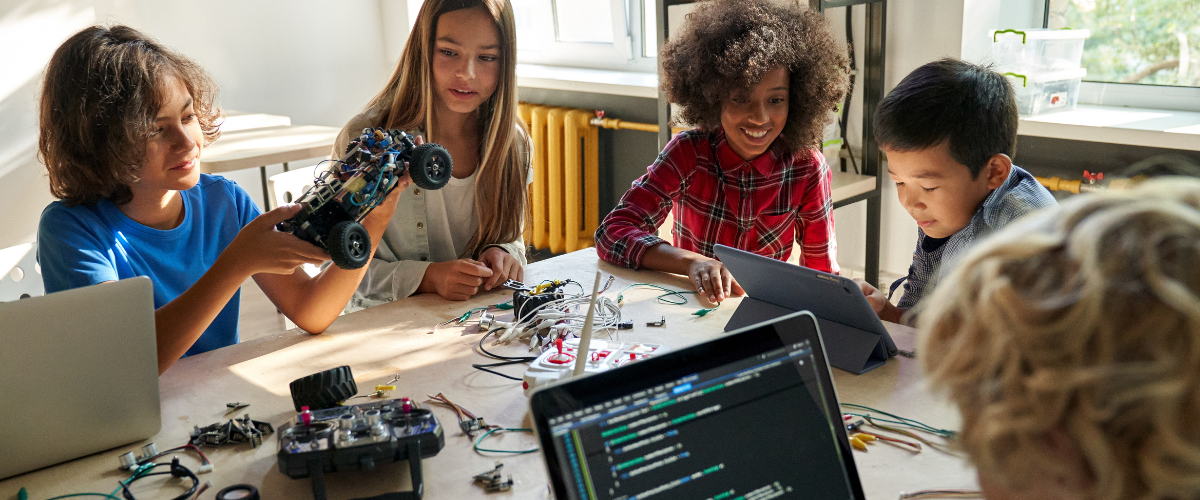Creativity is more important than ever. It’s not just a skill reserved for artists or writers—it’s a key driver of problem-solving, innovation, and adaptability. Nurturing creativity in the classroom can spark a lifelong love of learning and build foundational skills for elementary students' futures.
Why it Matters:
Studies show that creativity is on the decline in the United States. Data indicate that “children have become less emotionally expressive, less energetic, less talkative and verbally expressive, less humorous, less imaginative, less unconventional, less lively and passionate, less perceptive, less apt to connect seemingly irrelevant things, less synthesizing, and less likely to see things from a different angle.” With the rise of technology and AI, creativity is becoming an in-demand skill. In a 2010 IBM Global Survey of more than 1500 CEOs from 60 countries and 33 industries worldwide, creativity was selected as the most crucial factor for future success. It is no longer a nice to have skill.
Here are practical ways teachers can encourage creativity in their classrooms, fostering an environment where young minds can flourish.
10 Steps To Nurturing Creativity in Elementary Age
1. Create a Safe Space for Ideas
Creativity thrives in an environment where students feel safe to share their thoughts without fear of judgment.
How to Encourage This:
- Emphasize that all ideas are valuable, no matter how unconventional they seem.
- Celebrate effort over perfection to build confidence in students.
- Establish a classroom culture of respect and curiosity, where everyone’s contributions are acknowledged.
2. Integrate Open-Ended Projects
Unlike worksheets or rote exercises, open-ended projects allow students to explore topics uniquely.
How to Encourage This:
- Assign projects with multiple possible outcomes, such as creating a diorama, writing a story, or designing an invention.
- Provide students with various materials and tools to let their imaginations guide them.
- Encourage students to explain their thought process, highlighting the originality behind their work.
3. Foster Curiosity Through Questions
Encouraging students to ask questions is a powerful way to stimulate creative thinking.
How to Encourage This:
- Use prompts like, “What if…?” or “How might we…?” to spark curiosity.
- Allow students to lead discussions and explore their own questions during lessons.
- Build in time for inquiry-based learning, where students investigate topics that intrigue them.
4. Incorporate Play-Based Learning
Play is a natural way for children to experiment, solve problems, and express themselves creatively.
How to Encourage This:
- Use games and role-playing activities to make lessons engaging and interactive.
- Encourage imaginative play through storytelling, building with blocks, or creating puppet shows.
- Designate a portion of the day for unstructured playtime, where students can explore freely.

5. Use the Arts to Unlock Creativity
Art, music, and drama provide powerful outlets for self-expression and innovation.
How to Encourage This:
- Integrate visual arts into core subjects, such as illustrating a science concept or creating history timelines.
- Encourage musical exploration through singing, playing instruments, or composing simple songs.
- Use drama to reenact historical events, act out stories, or explore emotions.
6. Embrace Mistakes as Learning Opportunities
Fear of failure can stifle creativity. Teaching students to view mistakes as part of the learning process opens the door to experimentation.
How to Encourage This:
- Share stories of famous innovators like Thomas Edison, who succeeded through trial and error.
- Model a positive attitude toward mistakes by reflecting on your own learning experiences.
- Encourage students to iterate on their ideas and explore new approaches.
7. Collaborate and Brainstorm as a Class
Group activities encourage students to build on each other’s ideas and practice creative problem-solving.
How to Encourage This:
- Host brainstorming sessions where students generate ideas together.
- Assign group projects that require teamwork and creative thinking.
- Use collaborative tools like mind maps or storyboards to capture and connect ideas.
8. Incorporate Technology and Digital Tools
Technology offers endless opportunities for creative exploration, from coding to multimedia projects.
How to Encourage This:
- Introduce creative software like digital drawing apps or video editing tools.
- Encourage students to build digital presentations, animations, or simple games.
- Use interactive platforms to collaborate on projects or share creative work.
9. Connect Lessons to Real-World Problems
Solving real-world challenges encourages students to think critically and creatively.
How to Encourage This:
- Assign projects like designing solutions to environmental issues or planning a community event.
- Invite guest speakers who solve problems creatively in their professions.
- Encourage students to explore how they can make a difference in their local communities.
10. Encourage Reflection and Self-Expression
Reflection helps students process their learning and recognize their creative potential.
How to Encourage This:
- Use journaling as a tool for students to reflect on their experiences and ideas.
- Allow students to present their projects in a way that feels authentic to them.
- Create a “Creativity Wall” where students can display and celebrate their work.
The Role of Teachers in Inspiring Creativity
Teachers have a unique opportunity to shape how students view creativity. By fostering a supportive and inspiring environment, you can help students unlock their potential and develop critical thinking skills that extend far beyond the classroom.
Creativity isn’t about teaching students what to think—it’s about empowering them to think for themselves. Whether through open-ended projects, arts integration, or collaborative brainstorming, you can provide the tools and encouragement they need to shine.
By nurturing creativity, you’re not only preparing students for academic success but also equipping them to tackle challenges with confidence and originality throughout their lives.
Envision by WorldStrides is passionate about guiding students each step of the way as they rise to their highest potential through transformative experiences. Our programs offer hands-on experiences that allow high schoolers to test the waters of possible career tracks in:
background-image: a building with the American flag in front of it